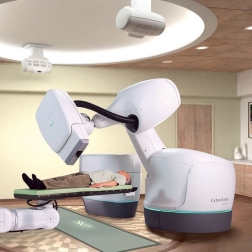Our Services
Cyberknife Radiosurgery

Overview
Stereotactic radiosurgery (SRS) is a highly precise form of radiation therapy. It uses sophisticated 3D imaging technology to target a narrow X-ray beam for delivery of a highly concentrated dose of radiation to the affected area. It fundamentally works in the same way as other forms of radiation treatment. It does not actually remove the tumor; but, damages the tumor cells. As a result, these cells lose their ability to reproduce. Following treatment, benign tumors usually shrink over a period of 18 months to two years. Many tumors will remain stable and inactive without any change. Since the aim is to prevent tumor growth, this is considered a success. When treated with SRS, arteriovenous malformations (AVMs) may begin to thicken and close off slowly over a period of several years following treatment.
Nonsurgical treatment for Brain Tumors
Radiosurgery makes it possible for neurosurgeons to reach the deepest recesses of the brain and correct disorders, without any surgical incision
Despite its name, SRS is a non-surgical procedure and does not involve incisions (cuts) on the body. The radiation dose is delivered with accuracy of a few millimetres. The high precision of the technology permits delivery of maximum radiation dose to the target area in lesser number of sessions, while minimizing dose to the surrounding healthy tissue. The goal is to deliver doses that will destroy the tumor and achieve permanent local control, while minimizing the side effects of radiation on the normal brain. Radiosurgery treatments are similar to having an x-ray. The patient will not be able to see, feel or hear the x-rays. In most cases, radiosurgery patients can resume all of their normal activities within one or two days.
Citi Neuro Centre partners with the CyberKnife system at Omega Hospitals to provide the best technology and clinical protocols into stereotactic radiotherapy services for its patients. The CyberKnife System is a unique, robotic system designed to deliver high-precision radiosurgical procedures. It is the only fully robotic radiation delivery system. The robotic design, coupled with real-time imaging, enable the CyberKnife System to deliver a maximum dose of radiation directly to the tumor from many different angles with sub-millimeter precision. The CyberKnife System does this by tracking and automatically adjusting for tumor or patient movement during treatment to minimize radiation exposure to healthy organs and tissues.
This technology makes it possible for neurosurgeons to reach the deepest recesses of the brain and correct disorders not treatable with conventional surgery. Since there is no incision, surgical risks such as infection are not an issue, and there is little discomfort. Adult patients may be lightly sedated but are awake throughout the procedure. Hospitalization is short and at most, requires an overnight stay. The majority of patients are treated on an outpatient basis. As a result, patients experience less discomfort and have much shorter recovery periods than having undergone conventional surgery.
Potential benefits of the CyberKnife system include:
- No need for immobilization
- No incision
- No pain
- No anesthesia or hospitalization
- Greater comfort (patient can breathe normally during treatment)
- Little or no recovery time
- Immediate return to normal activities
Stereotactic radiosurgery may be used for selected cases of benign brain tumors (such as acoustic neuromas, meningiomas, pineal tumors, pituitary tumors), malignant brain tumors (such as astrocytomas), metastatic brain tumors, brain vascular malformations, trigeminal neuralgia and other functional procedures.